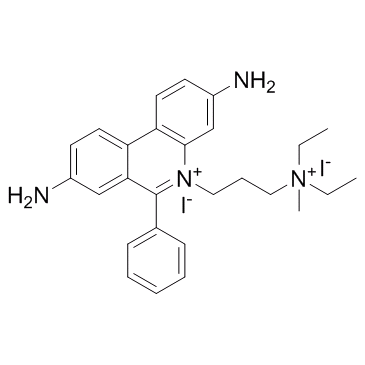Propidium Iodide

Propidium Iodide structure
|
Common Name | Propidium Iodide | ||
|---|---|---|---|---|
| CAS Number | 25535-16-4 | Molecular Weight | 668.395 | |
| Density | N/A | Boiling Point | N/A | |
| Molecular Formula | C27H34I2N4 | Melting Point | 220-225 °C (dec.)(lit.) | |
| MSDS | Chinese USA | Flash Point | N/A | |
| Symbol |


GHS07, GHS08 |
Signal Word | Warning | |
|
Epigenetic reprogramming of the type III interferon response potentiates antiviral activity and suppresses tumor growth.
PLoS Biol. 12(1) , e1001758, (2014) Type III interferon (IFN-λ) exhibits potent antiviral activity similar to IFN-α/β, but in contrast to the ubiquitous expression of the IFN-α/β receptor, the IFN-λ receptor is restricted to cells of epithelial origin. Despite the importance of IFN-λ in tissue-... |
|
|
ZEB2 drives immature T-cell lymphoblastic leukaemia development via enhanced tumour-initiating potential and IL-7 receptor signalling.
Nat. Commun. 6 , 5794, (2015) Early T-cell precursor leukaemia (ETP-ALL) is a high-risk subtype of human leukaemia that is poorly understood at the molecular level. Here we report translocations targeting the zinc finger E-box-binding transcription factor ZEB2 as a recurrent genetic lesio... |
|
|
RETRA exerts anticancer activity in Ewing's sarcoma cells independent of their TP53 status.
Eur. J. Cancer 51(7) , 841-51, (2015) Mutant p53 can exert oncogenic activity by inhibitory interaction with p73. The small-molecule RETRA has been described to disrupt this interaction and to suppress carcinoma cells (Kravchenko et al., 2008). RETRA's anticancer activity was restricted to tumour... |
|
|
Pro-apoptotic and pro-autophagic effects of the Aurora kinase A inhibitor alisertib (MLN8237) on human osteosarcoma U-2 OS and MG-63 cells through the activation of mitochondria-mediated pathway and inhibition of p38 MAPK/PI3K/Akt/mTOR signaling pathway.
Drug Des. Devel. Ther. 9 , 1555-84, (2015) Osteosarcoma (OS) is the most common malignant bone tumor occurring mostly in children and adolescents between 10 and 20 years of age with poor response to current therapeutics. Alisertib (ALS, MLN8237) is a selective Aurora kinase A inhibitor that displays a... |
|
|
Alisertib, an Aurora kinase A inhibitor, induces apoptosis and autophagy but inhibits epithelial to mesenchymal transition in human epithelial ovarian cancer cells.
Drug Des. Devel. Ther. 9 , 425-64, (2015) Ovarian cancer is a leading killer of women, and no cure for advanced ovarian cancer is available. Alisertib (ALS), a selective Aurora kinase A (AURKA) inhibitor, has shown potent anticancer effects, and is under clinical investigation for the treatment of ad... |
|
|
TRPV4 channel activity is modulated by direct interaction of the ankyrin domain to PI(4,5)P₂.
Nat. Commun. 5 , 4994, (2014) Mutations in the ankyrin repeat domain (ARD) of TRPV4 are responsible for several channelopathies, including Charcot-Marie-Tooth disease type 2C and congenital distal and scapuloperoneal spinal muscular atrophy. However, the molecular pathogenesis mediated by... |
|
|
Insulin-like growth factor 1 increases apical fibronectin in blastocysts to increase blastocyst attachment to endometrial epithelial cells in vitro.
Hum. Reprod. 30(2) , 284-98, (2015) Does insulin-like growth factor 1 (IGF1) increase adhesion competency of blastocysts to increase attachment to uterine epithelial cells in vitro?IGF1 increases apical fibronectin on blastocysts to increase attachment and invasion in an in vitro model of impla... |
|
|
SETD6 controls the expression of estrogen-responsive genes and proliferation of breast carcinoma cells.
Epigenetics 9(7) , 942-50, (2014) The lysine methyltransferase SETD6 modifies the histone variant H2AZ, a key component of nuclear receptor-dependent transcription. Herein, we report the identification of several factors that associate with SETD6 and are implicated in nuclear hormone receptor... |
|
|
Methionine oxidation accelerates the aggregation and enhances the neurotoxicity of the D178N variant of the human prion protein.
Biochim. Biophys. Acta 1842(12 Pt A) , 2345-56, (2014) The D178N mutation of the prion protein (PrP) results in the hereditary prion disease fatal familial insomnia (FFI). Little is known regarding the effects of methionine oxidation on the pathogenesis of D178N-associated FFI. In the present study, we found that... |
|
|
The antimicrobial mechanism of action of epsilon-poly-l-lysine.
Appl. Environ. Microbiol. 80(24) , 7758-70, (2014) Epsilon-poly-l-lysine (ε-PL) is a natural antimicrobial cationic peptide which is generally regarded as safe (GRAS) as a food preservative. Although its antimicrobial activity is well documented, its mechanism of action is only vaguely described. The aim of t... |